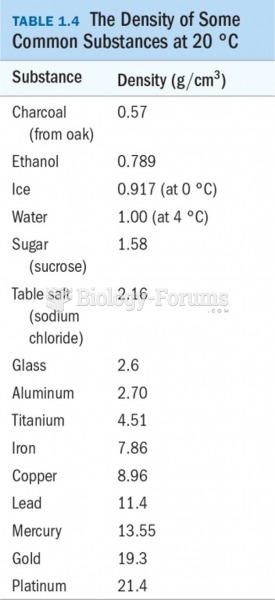Answer to Question 1
Myth: Liquors such as rum, vodka, and tequila are more harmful than wine and beer.
Truth: The damage caused by alcohol depends largely on the amount consumed. Compared with liquor, beer and wine have relatively low percentages of alcohol, but they are often consumed in larger quantities.
Myth: Consuming alcohol with raw seafood diminishes the likelihood of getting hepatitis.
Truth: people have eaten contaminated oysters while drinking alcoholic beverages and not gotten as sick as those who were not drinking. But do not be misled: hepatitis is too serious an illness for anyone to depend on alcohol for protection.
Myth: Alcohol stimulates the appetite.
Truth: For some people, alcohol may stimulate appetite, but it seems to have the opposite effect in heavy drinkers. Heavy drinkers tend to eat poorly and suffer malnutrition.
Myth: Drinking alcohol is healthy.
Truth: Moderate alcohol consumption is associated with a lower risk for heart disease. Higher intakes, however, raise the risks for high blood pressure, stroke, heart disease, some cancers, accidents, violence, suicide, birth defects, and deaths in general. furthermore, excessive alcohol consumption damages the liver, pancreas, brain, and heart. No authority recommends that nondrinkers begin drinking alcoholic beverages to obtain health benefits.
Myth: Wine increases the body's absorption of minerals.
Truth: Wine may increase the body's absorption of potassium, calcium, phosphorus, magnesium, and zinc, but the alcohol in wine also promotes the body's excretion of these minerals, so no benefit is gained.
Myth: Alcohol is legal, and, therefore, not a drug.
Truth: Alcohol is legal for adults 21 years old and older, but it is also a druga substance that alters one or more of the body's functions.
Myth: A shot of alcohol usually warms you up.
Truth: Alcohol diverts blood flow to the skin making you feel warmer, but it actually cools the body.
Myth: Wine and beer are mild; they do not lead to alcoholism.
Truth: Alcoholism is not related to the kind of beverage, but rather to the quantity and frequency of consumption.
Myth: Mixing different types of drinks gives you a hangover.
Truth: Too much alcohol in any form produces a hangover.
Myth: Alcohol is a stimulant.
Truth: People think alcohol is a stimulant because it seems to relieve inhibitions, but it does so by depressing the activity of the brain. Alcohol is medically defined as a depressant drug.
Myth; Beer is a great source of carbohydrate, vitamins, minerals, and fluids.
Truth: Beer does provide some carbohydrate, but most of its kcalories come from alcohol. The few vitamins and minerals in beer cannot compete with rich food sources. And the diuretic effect of alcohol causes the body to lose more fluid in urine than is provided by the beer
Answer to Question 2
The dangers of binge drinking have been amplified by the use of beverages that contain caffeine as an additive. The caffeine seems to mask the sensory cues that an individual normally relies on to determine intoxication. Consequently, individuals drinking these beverages typically consume more alcohol and become more intoxicated than they realize. The Food and Drug Administration (FDA) has warned manufacturers of packaged caffeinated alcoholic beverages to stop sales. The combination of alcohol and added caffeine has not been approved because these products are associated with risky behaviors that may lead to hazardous and life-threatening situations.







